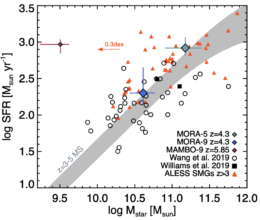Editor’s note: Astrobites is a graduate-student-run organization that digests astrophysical literature for undergraduate students. As part of the partnership between the AAS and astrobites, we occasionally repost astrobites content here at AAS Nova. We hope you enjoy this post from astrobites; the original can be viewed at astrobites.org.
Title: Characterization of Two 2 mm detected Optically Obscured Dusty Star-forming Galaxies
Authors: Sinclaire Manning et al.
First Author’s Institution: The University of Texas at Austin and University of Massachusetts, Amherst
Status: Published in ApJ
Dusty star-forming galaxies could be important for learning what drives star formation, since they have been observed to have extremely high star-formation rates. These galaxies could also be predecessors to some quenched galaxies that have stopped forming stars at high redshift. However, due to observational challenges, it is relatively uncertain how common dusty star-forming galaxies are at high redshift.
Ultraviolet and optical light from young stars in dusty star-forming galaxies gets absorbed by large amounts of dust and re-emitted in the infrared. In some cases, there is so much dust that the optical emission from the galaxy is heavily obscured and all we can observe is the light re-emitted by the dust. When galaxies are undetectable (meaning they either can’t be observed or their presence can’t be confirmed) in both optical and near-infrared light, we call them OIR-dark galaxies.
At high redshift, dusty star-forming galaxies are observable at long wavelengths with telescopes like the Atacama Large Millimeter/submillimeter Array (ALMA). The authors of today’s article investigate two OIR-dark galaxies from the Mapping Obscuration to Reionization ALMA (MORA) survey and measure their redshifts and physical properties.
Dusty, Dark, and Distant
The two galaxies, MORA-5 and MORA-9, have been observed in multiple wavelengths with ALMA and other telescopes like the Hubble Space Telescope. What makes them interesting is that they are detected in ALMA observations but not in optical or near-infrared wavelengths, so they are considered OIR-dark. The availability of multi-wavelength observations allows the authors to study the galaxies’ spectral energy distributions (SEDs), which tell us how a galaxy’s energy is distributed over different wavelengths. The shape of a galaxy’s SED depends on properties such as the rate of star formation and gas mass, so fitting the SED can give us a clue about the physical environment of the galaxy.
Before they can determine the properties of these galaxies, the authors must obtain their redshifts. One way to measure redshift is using spectroscopy, since the wavelengths of galactic emission lines get shifted depending on their distance to us. Since spectroscopic data for these galaxies are not available, the authors use three different methods to estimate redshift from the SEDs. Figure 1 shows the SEDs of these two galaxies and the fitting results from these three methods.

Figure 1: Spectral energy distributions of MORA-5 (top) and MORA-9 (bottom). The blue line shows the fit to the OIR part of the SED from EAZY. The orange line shows the fit from MMpz to the far-infrared part of the SED. The black line shows the combination of these two models. The gray and purple lines show the MAGPHYS fitting of the entire range of the SED for 3 different redshifts. [Manning et al. 2022]
Galaxy Properties
After estimating the redshifts, the authors estimate the physical properties of these galaxies. First, they once again use correlations between the infrared luminosity and other galaxy properties, but this time to estimate the star-formation rate. They estimate that in one year MORA-9 forms 200 solar masses of stars. MORA-5, on the other hand, forms roughly four times as many stars, with a star-formation rate of 830 solar masses per year! The authors also estimate the mass of the galaxy that comes from stars, gas, and dust.

Figure 2: Star-formation rate (in solar masses per year) vs. stellar mass (in solar masses) of dusty star-forming galaxies from different surveys. The blue and green diamonds represent the MORA galaxies discussed in this article. The gray shaded area represents the main sequence that galaxies follow for star formation at a redshift of z=3–5. [Manning et al. 2022]
To figure out how common these galaxies are, the authors look at two other galaxies, MORA-3 and MORA-4, and estimate the volume density of OIR-dark galaxies to be 5 x 10-6 Mpc-3. The authors note that it’s unclear why some dusty star-forming galaxies are OIR-dark while others aren’t, and they suggest it could simply be dependent on their redshift. Regardless of what makes this class of galaxies OIR-dark, they provide a way to study the environments of distant star-forming galaxies that are otherwise invisible.
Original astrobite edited by Jamie Sullivan.
About the author, Gloria Fonseca Alvarez:
I’m a fifth-year graduate student at the University of Connecticut. My research focuses on the inner environments of supermassive black holes. I am currently working on measuring black hole properties from the spectral energy distributions of quasars in the Sloan Digital Sky Survey. As a Nicaraguan astronomer, I am also involved in efforts to increase the participation of Central American students in astronomy research.

